Hog is a farm animal raised throughout the world. These animals provide pork, which is eaten as pork chops, ham, bacon, and sausage. The fat, skin, hair, glands, and other parts of hogs are used to make a variety of products. Such products include lard, leather, brushes, soap, fertilizer, glue, and medicines.
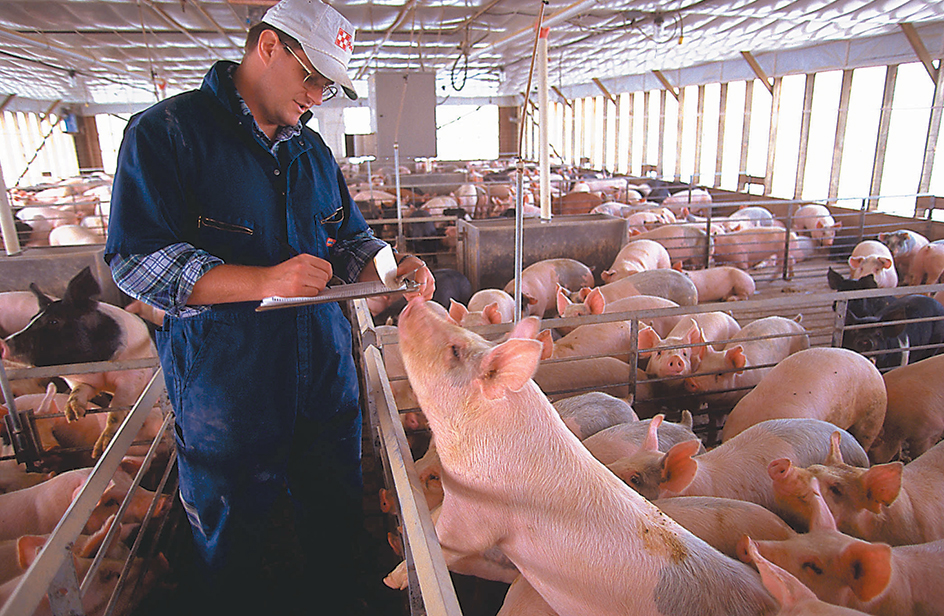
Both young and adult hogs are also called pigs or swine. Young hogs are almost always called pigs. Farmers who raise hogs are called pork producers. Hogs rank among the most intelligent of the domesticated (tamed) animals. Some people consider them dirty, yet hogs keep themselves cleaner than most other farm animals do. However, hogs will often wallow (roll about) in mud to cool themselves during warm periods.
About 1 billion hogs live on farms throughout the world. Approximately half of these hogs are raised in China, the world’s leading hog-producing country. Hogs rank with cattle, poultry, and dairy products as an important source of the world’s farm income.
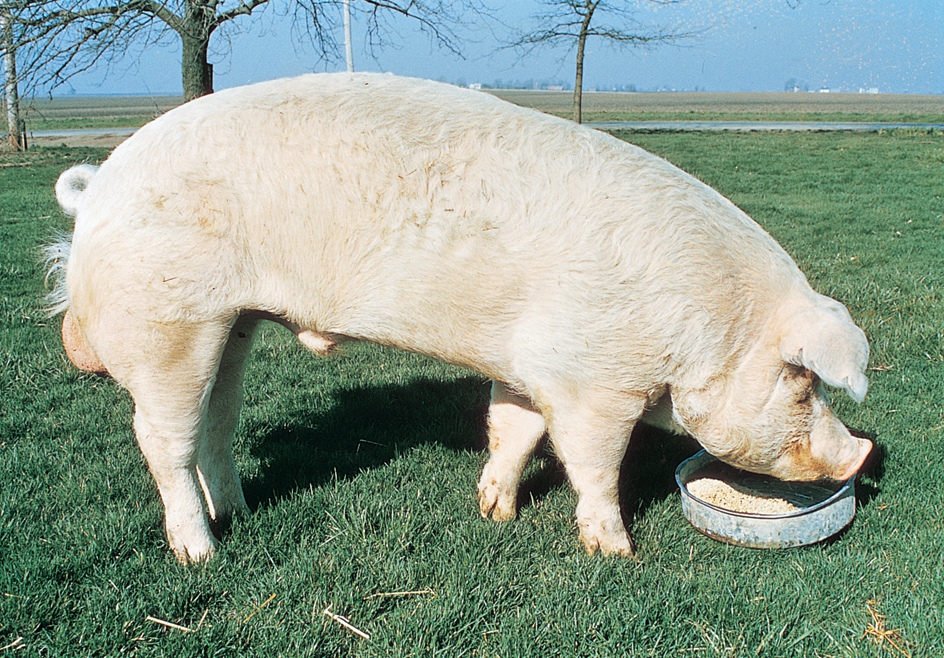
Selective breeding, better housing, and more nutritious feeds have resulted in improvements in hogs. Hogs today grow faster on less feed and produce more lean meat and less fat than did hogs that were raised in the past.
One of the main ingredients in hog feed is corn. Hogs eat about 20 percent of the corn that is grown in the United States. European farmers commonly feed barley to their hogs. In countries with large dairy industries, such as Denmark, much skimmed milk is available for feeding hogs.
Kinds of hogs
There are many kinds of hogs raised around the world. Because hogs have a short reproduction cycle, new breeds can be developed over a relatively short time. Often, such breeds of hogs reflect the climate and production methods of the region in which they are raised. In Europe, for example, each country has developed its own breeds of hogs. In North America, regional differences among the various hog breeds are slight.
Farmers in many countries raise chiefly crossbred hogs. Crossbred hogs are produced by mating parents of different breeds. Crossbreds, also called hybrids, are more active at birth and grow more rapidly than purebreds. They also have higher reproduction rates than purebred hogs.
Hogs raised in the United States are classified as meat-type hogs. Meat-type hogs produce more lean meat in proportion to fat. Pork from such hogs is low in fat and provides an excellent source of high-quality protein.
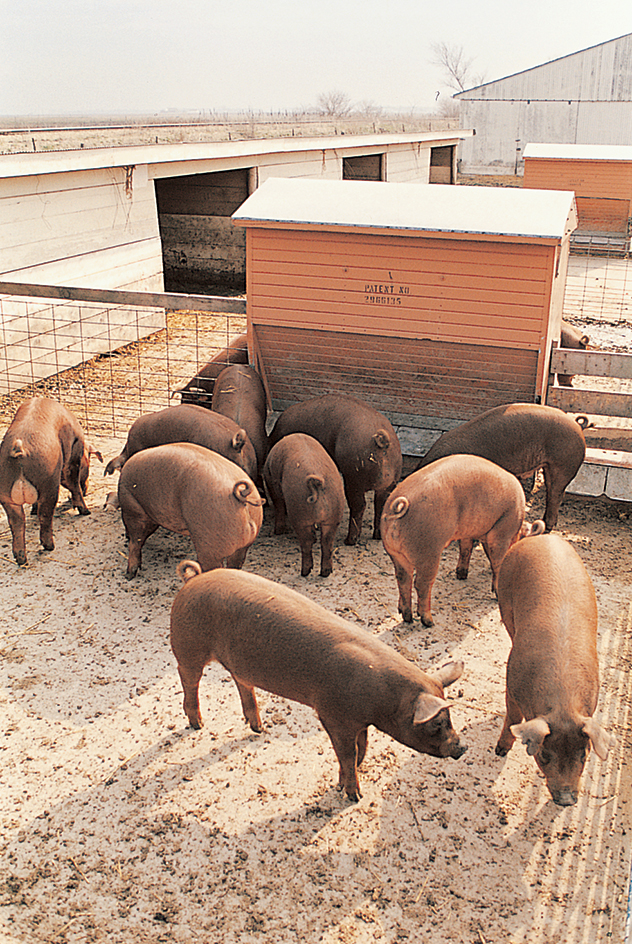
United States breeds.
The eight commonly raised breeds of hogs in the United States are the American Landrace, Berkshire, Chester White, Duroc, Hampshire, Poland China, Spotted Swine, and Yorkshire. Farmers in the United States developed all these breeds except the Berkshire and Yorkshire, which were imported from the United Kingdom in the 1800’s. The American Landrace breed includes hogs bred from Landrace stock from such countries as Denmark, Germany, Sweden, and the United Kingdom. No one breed is greatly superior in its ability to produce meat or to grow swiftly.
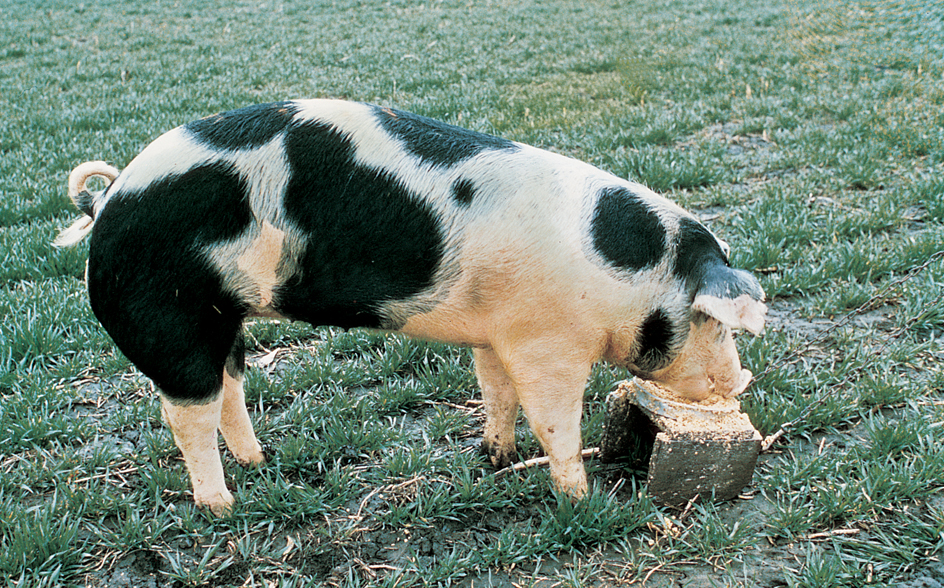
Other breeds.
Common breeds of hogs in Europe include the Large White and the Landrace. Most European countries have their own Landrace breed. All such hogs are white and have droopy ears. The Large White is related to the Yorkshire breed in the United States. Pietrain is a muscular breed developed in Belgium, Luxembourg, and the Netherlands. There are about 40 breeds of hogs raised in China.
Wild hogs
are strong, fierce animals that live in forests and jungles in many parts of the world. They include the babirusa of Indonesia, the warthog of Africa, and the wild boar that lives in some parts of Europe, Asia, and Africa. Razorbacks, wild hogs with sharp, narrow backs, live in the southeastern United States and in the Caribbean region. They are descended from tame hogs that escaped from farms and became wild again. Peccaries are wild, piglike animals that live in some parts of North and South America. They are not true hogs. See Babirusa ; Boar, Wild ; Peccary ; Warthog . 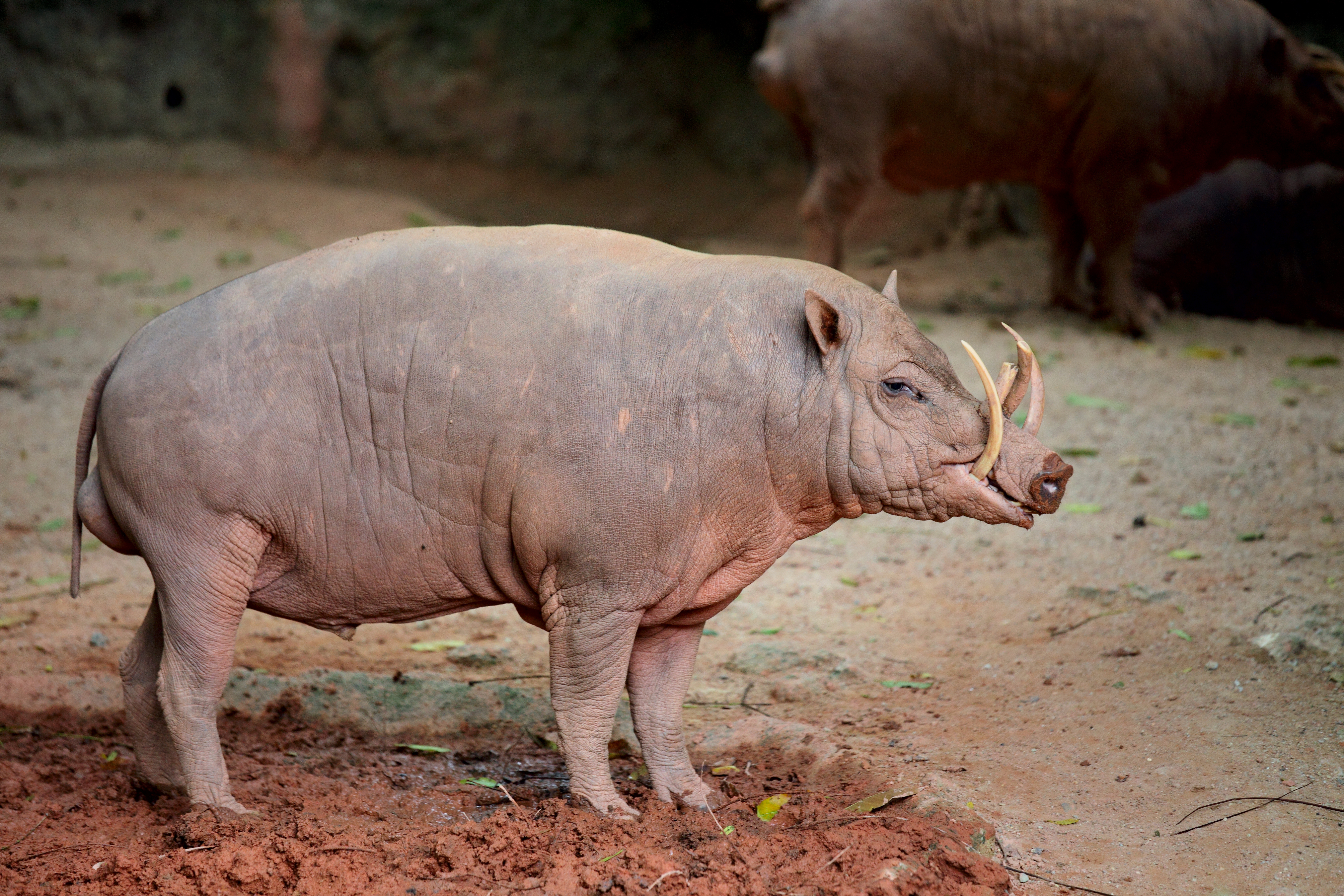
How we use hogs
Food.
We eat the meat of hogs as pork chops, spareribs, loin roasts, ham, bacon, and sausage. Popular sausages made from pork include wieners, bologna, bratwurst, mettwurst, braunschweiger, and salami. Some hog meat, such as pig’s feet and knuckles, is pickled. Chitterlings (hog intestines) and fried pig skin are popular foods in some regions of the United States. People also eat such hog parts as the stomach, kidneys, liver, ears, brain, snout, jowls, lips, tongue, and throat. Lard used for cooking is made from hog fat. Some religions, such as Islam and Judaism, forbid their followers to eat pork.
Other uses.
Tanneries process the skins of hogs into leather used for such products as belts, gloves, jackets, and shoes. The hair of the hog provides bristles for brushes. It is also used to stuff mattresses and baseball gloves. Hog blood is used to produce animal feeds, fertilizer, and medicines. Drug firms make insulin, ACTH, and other medicines from hog glands. Surgeons use valves from the hearts of hogs to replace defective heart valves in humans. People use specially prepared hog skin to treat burns. Hog fat is made into lard, soap, candles, salves, shaving cream, explosives, and lubricating oils. The bones of the hog are ground for glue, fertilizer, and animal feeds.
The bodies of hogs
The hog has a stout, strong body covered with coarse, bristly hair. Its head and short, thick neck extend in a straight line from the body. The head ends in a snout. A hog’s thick skin has no sweat glands to serve as a cooling system. Hogs like to wallow in mud because it helps them keep cool. Hogs have small eyes and poor eyesight. But a keen sense of smell helps them find food. They have short tails that are usually curled. Hogs grunt and, when hurt or excited, squeal. 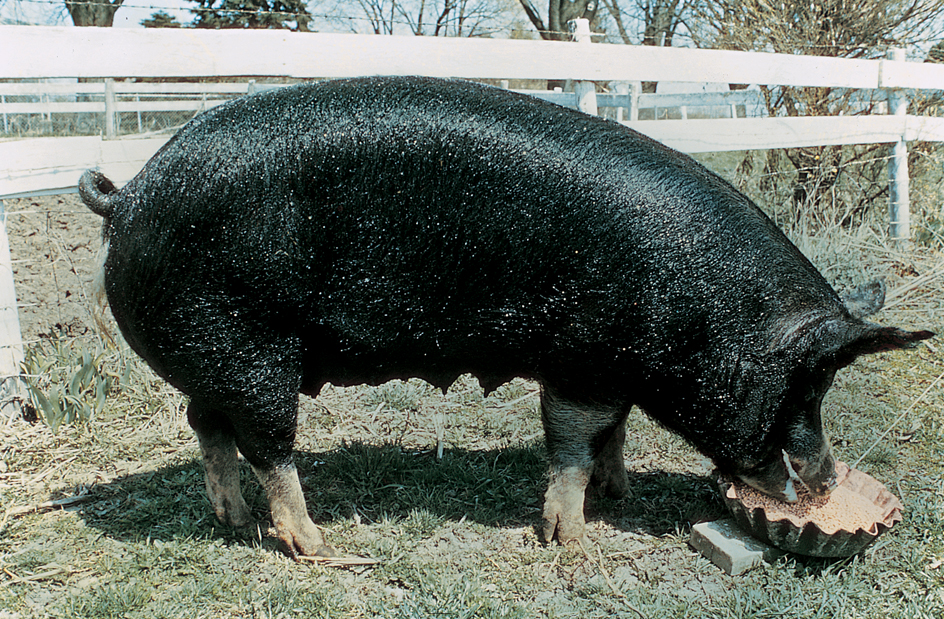
Size.
Pigs weigh about 21/2 pounds (1.1 kilograms) at birth, and usually double their weight in the first week. When fully grown, boars may weigh more than 500 pounds (230 kilograms) and sows more than 450 pounds (200 kilograms). The average adult boar weighs from 350 to 500 pounds (160 to 230 kilograms) and the average adult sow from 300 to 450 pounds (140 to 200 kilograms). Most hogs are sold when they are 6 to 7 months old and weigh 220 to 265 pounds (100 to 120 kilograms). Hogs kept longer are usually used for breeding.
Snout.
The hog’s snout has a broad, leathery pad that includes the nostrils. The snout is very sensitive to touch. Hogs raised outdoors often use their snouts to root, or dig, for vegetable roots, a favorite food.
Teeth.
Hogs have from 34 to 44 teeth, depending on the species. Eight of these are canine teeth (pointed teeth) that often develop into sharp tusks, particularly in adult males. The tusks serve as tools for digging and as weapons. Farmers may clip tusks off mature boars because they can cause injury. A hog protects itself by running away. But if cornered, the hog may charge and bite.
Feet.
The hog has four toes on each foot. Each toe ends in a hoof. The two middle hoofs are divided on all hogs except the Mule-Foot breed. Mule-Foot hogs have a solid, or single-toed, hoof in the middle of each foot. The two other toes on each foot do not touch the ground when the hog stands.
Life history.
Hogs reproduce rapidly and can mate when about 8 months old. Sows carry their young about 114 days before farrowing (giving birth). Sows usually give birth to 9 to 15 pigs at a time, but the number may be 27 or more. Hogs reach full growth at 11/2 to 2 years of age and can live from 9 to 15 years. But most hogs are marketed when they are 6 to 7 months old.
Raising hogs
Feeding.
Farmers provide hogs with well-balanced diets. Carbohydrates from corn and such grains as sorghum, barley, wheat, rye, and oats provide energy. Meals made from soybeans, linseed, cottonseed, peanuts, fish and meat scraps, skim milk, and tankage supply protein. Tankage is a feed made from the bones, tendons, and other parts of animals.
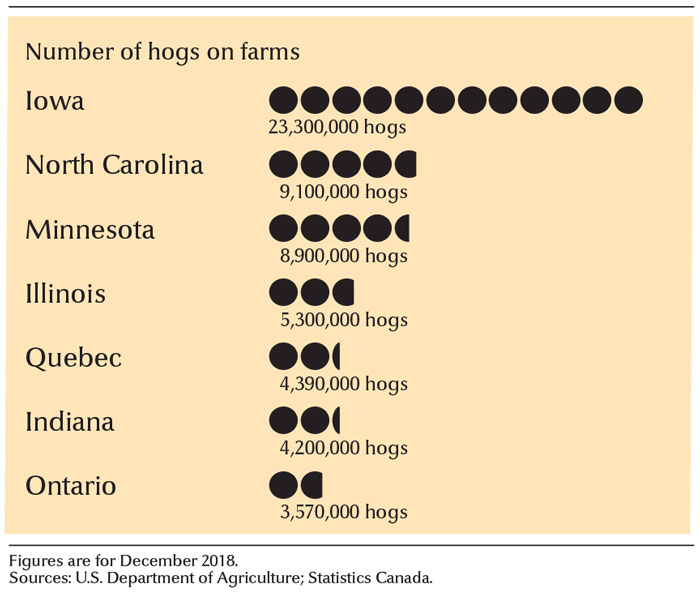
Farmers usually feed hogs complete diets, including vitamins and minerals. Diets contain everything hogs need to grow rapidly and efficiently.
Shelter.
Many hogs spend their entire lives indoors. Their housing keeps the hogs comfortable and clean. These buildings may be partially open so that fresh air can come inside. Buildings in cooler climates may be completely enclosed and have mechanical systems that provide fresh air and control the temperature. Farmers that raise hogs outdoors keep the hogs in pastures or dirt lots. Such lots feature several small hog houses. Even if farmers choose to raise their hogs outdoors, most young hogs spend their first few months inside. Farmers move them to open lots when they are older.
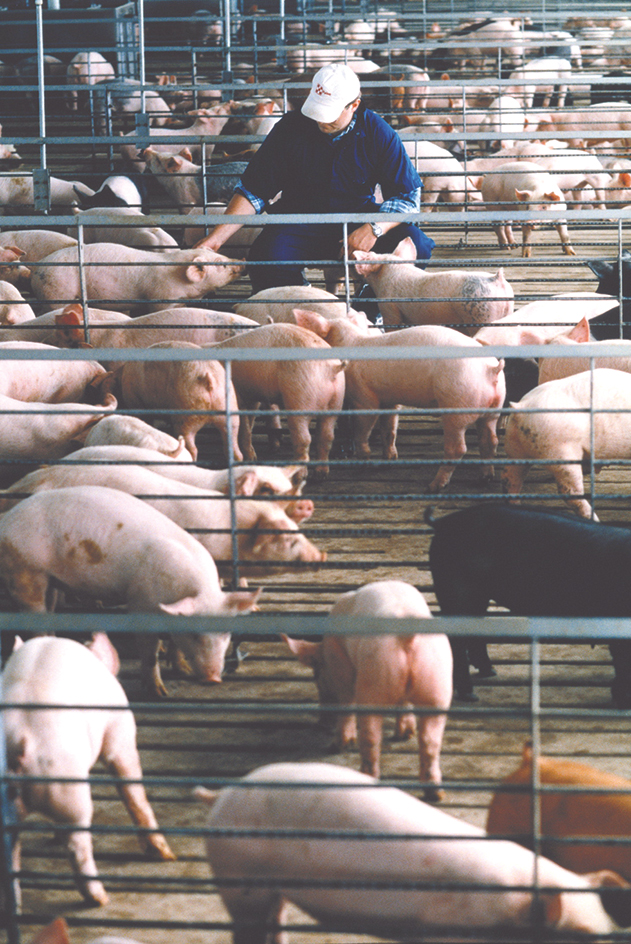
Diseases.
The most common diseases that attack hogs include respiratory infections, flu, and digestive disorders that cause diarrhea. Mange is a skin disease caused by tiny organisms called mites that burrow into the hog’s skin. Hogs also may become infested with lice. Farmers kill mites and lice by spraying hogs with insecticides. Pork infested with trichina worms can cause the disease trichinosis in people who eat the pork. Proper cooking of pork kills trichina worms. Hogs infested with trichina worms are rare.
Farrowing.
A few days before a sow farrows, the farmer washes it and places it in a clean pen. The farmer must take special care to prevent the sow from crushing its young when it lies down. Most pork producers use farrowing stalls that confine the sow to a small space, but enable the pigs to move about. Farmers usually provide the pigs with heated sleeping areas. In addition to keeping them warm, the heat attracts the pigs and keeps them out of the sow’s way.
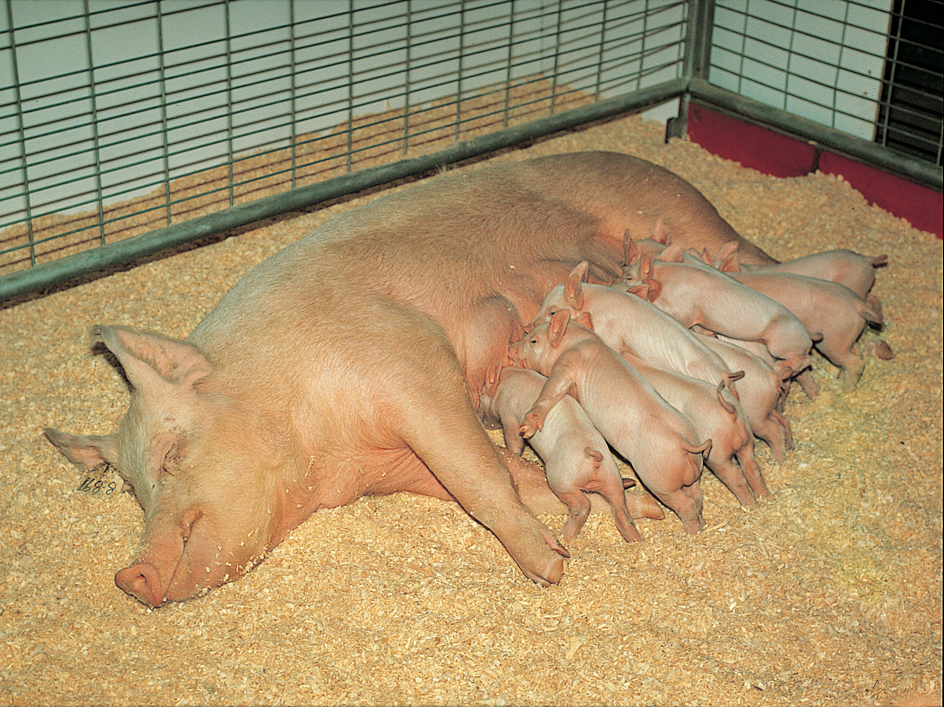
Sows usually nurse their pigs for 3 to 5 weeks. After the pigs are weaned (taken off their mother’s milk), they are fed a diet rich in protein. During this period, pigs are kept in houses called nurseries.
Marketing hogs.
In the past, pigs were farrowed only during seasons with mild temperatures, generally spring and fall, and then marketed six to seven months later. Modern production methods enable pork producers to farrow and market pigs throughout the year. This practice provides a consistent supply of pork products to consumers and makes better use of production facilities. Most pork producers sell their hogs directly to meat-processing plants.
History
Wild boars roamed throughout Europe and other parts of the world as long as 6 million years ago. Scientists believe people began taming hogs about 8,000 years ago, during the Stone Age. Explorers and colonists from Spain, England, and other countries brought hogs to North and South America in the early 1500’s.
Until the mid-1900’s, farmers commonly raised hogs for two basic purposes: the production of meat and the production of lard. Hogs raised for lard had more fat in proportion to lean meat. Meat-packing plants made hog fat into lard that was used for cooking and other purposes. Shortenings made from vegetable oils largely replaced lard in the 1950’s. In addition, petroleum products replaced lard as a lubricant and in the manufacture of soap. Farmers then began raising more hogs for meat.
Beginning in the 1970’s, the number of farms raising hogs began to decline. Many countries now raise most of their hogs on large, specialized farms rather than on small family farms.
